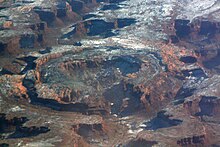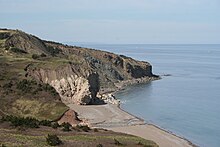
Back Купол (геология) Bulgarian গম্বুজ (ভূতত্ত্ব) Bengali/Bangla Dom (geologia) Catalan Dom (Geologie) German Domo (geología) Spanish Domo (geologia) Basque گنبد (زمینشناسی) Persian Doomi Finnish Duomo (geologia) Italian Duom JAM




A dome is a feature in structural geology where a circular part of the Earth's surface has been pushed upward, tilting the pre-existing layers of earth away from the center. In technical terms, it consists of symmetrical anticlines that intersect each other at their respective apices. Intact, domes are distinct, rounded, spherical-to-ellipsoidal-shaped protrusions on the Earth's surface. A slice parallel to Earth's surface of a dome features concentric rings of strata. If the top of a dome has been eroded flat, the resulting structure in plan view appears as a bullseye, with the youngest rock layers at the outside, and each ring growing progressively older moving inwards. These strata would have been horizontal at the time of deposition, then later deformed by the uplift associated with dome formation.[1][2]
- ^ Fossen, Haakon (2016). Structural geology. Cambridge University Press. ISBN 978-1-316-47295-8.
- ^ Monroe, James S. and Reed Wicander. The Changing Earth: Exploring Geology and Evolution. 2nd ed. Belmont: Wadsworth Publishing Company, 1997. ISBN 0-314-09577-2
© MMXXIII Rich X Search. We shall prevail. All rights reserved. Rich X Search